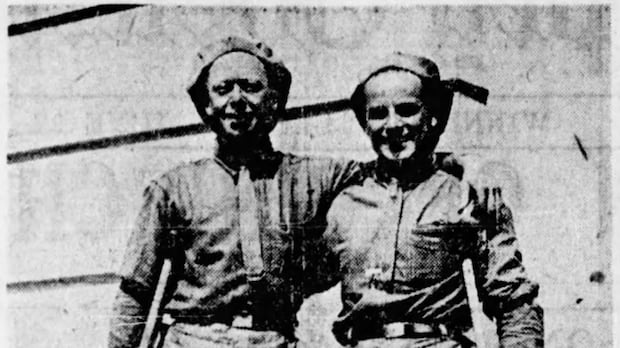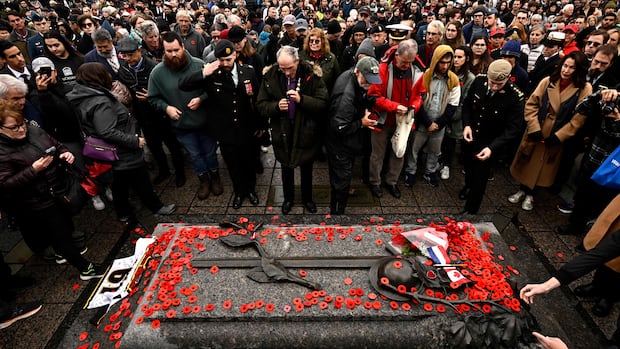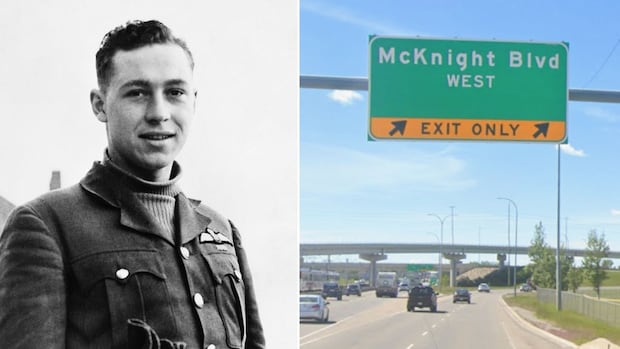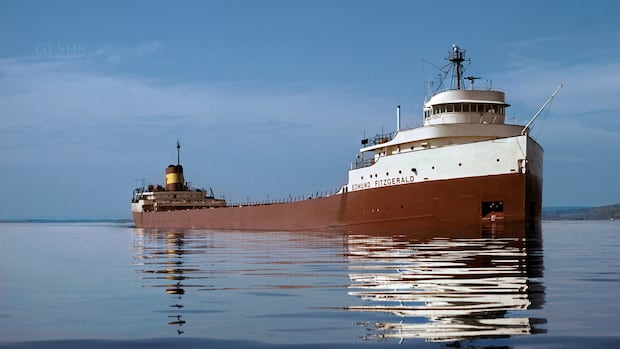Listen to this article
Estimated 4 minutes
The audio version of this article is generated by text-to-speech, a technology based on artificial intelligence.
Every day, thousands of Calgarians drive along McKnight Boulevard, a major east-west road in the city's north.
But not all of them may know that the road honours William McKnight, a prominent Canadian flying ace with the Royal Air Force during the Second World War.
Born in Edmonton in 1918, McKnight spent his childhood in Calgary, growing up in the neighbourhood of Crescent Heights.
He joined the British Royal Air Force under what was called a short-service commission as part of a largely-Canadian unit, formed before a Royal Canadian Air Force presence could be established.
When the conflict began is where McKnight started to shine, local historian Shelly McElroy told The Calgary Eyeopener.
 Local historian Shelly McElroy is writing a book about William McKnight. (Submitted by Shelly McElroy)
Local historian Shelly McElroy is writing a book about William McKnight. (Submitted by Shelly McElroy)“He was a very, very high-profile and dedicated and elite pilot,” said McElroy, who’s writing a book about McKnight.
McElroy said she stumbled onto McKnight’s story by accident.
While giving a talk on Calgary Stampeder football players who had served in the war, McElroy mentioned McKnight’s name.
“What I didn’t know was that William McKnight himself was watching. And of course, I don't mean that William McKnight, I'm talking about his nephew," McElroy said.
"He reached out to me … and I got to see documents, photographs, a letter from Bill, as he called himself, that historians didn’t know about. That kicked off this whole entire thing."
LISTEN | Remembering William McKnight on Remembrance Day:Calgary Eyeopener8:39Remembering William McKnight on Remembrance Day
A look at the life of the Calgarian and Second World War pilot who gave his name to a prominent boulevard in the city.According to the Royal Canadian Air Force, McKnight downed 17 German planes during his career, and is credited as Canada's highest scoring ace of the Battle of Britain.
"Only about one in 100 fighter pilots ever became an ace. Most never fired their guns. And if they did, they missed," McElroy said. "So just to kind of put that into context."
To be considered a flying ace during the Second World War, pilots had to be credited with shooting down five or more aircraft.
Over the beach of Dunkirk, the Royal Canadian Air Force said McKnight shot down 10 planes and scored six victories in four days. He flew with the 242 Squadron, otherwise known as "all Canadian" due to the number of Canadians serving in it.
"On August 30, 1940, during the Battle of Britain, McKnight had three kills in one day: two Messerschmitt Bf 109s and a Henkel He 111," the Royal Canadian Air Force wrote in 2015.
"The hockey-wise Canadians dubbed his feat a 'hat-trick.'"
His flying abilities earned the respect of his commanding officer, the famous pilot Douglas Bader, who flew with two artificial legs.
"All the Canadians seemed fearless and none more so than Willie McKnight, a flinty-eyed little dead-shot of twenty from Calgary, who had already knocked down several German aircraft in the shambles over France," reads an excerpt from Reach for the Sky, a 1954 biography of Bader written by Paul Brickhill.
"Under the tender lips he was a tough little man … [with] a weakness for soft music; he had a large collection of Bing Crosby records and played them endlessly in the mess in the evenings."
 William McKnight, left, stands with squadron leader Douglas Bader, middle, and flight lieutenant Eric Ball (Imperial War Museums, CH 1342)
William McKnight, left, stands with squadron leader Douglas Bader, middle, and flight lieutenant Eric Ball (Imperial War Museums, CH 1342)On January 12, 1941, McKnight’s Hurricane aircraft disappeared during a mission over the English Channel. He has no known grave and was 23 years old when he went missing.
Bader later made several visits to Calgary, and was quoted in the Calgary Herald in 1957 as saying that "all the good fortune I have had during and since the war can be placed squarely at the feet of Canadians.”
"[Bader] was the person that really encouraged the leaders in Calgary to consider naming a road leading to the airport for McKnight," McElroy said.
McElroy will give a presentation on the life of McKnight at the Central Public Library on Nov. 18.











